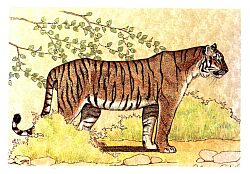English: Tiger; French: Tigre; Akas: Schi; Bahasa Java: Macan; Bahasa Sunda: Maung; Baluchi: Mazar; Bengali: Go-vagh; Bothias: Tuk; Burmese: Kya; Chinese: Hu; Hindi: Nahar, Sela-vagh; Hindustani; Bagh, Sher; Kachari: Misi; Karens: Khi, Botha-o, Tupuli; Khampti: Su; Kiki: Humpi; Kols: Garumkula; Kons: Krodi; Korean: Haakok; Kurgs: Nari; Limbu: Keh-va; Mahrati: Wahag, Patayat-bagh; Malabari: Perain-puli; Malay: Rimau, Arimau, Harimau; Manipuri: Kei, Kudua; Naga: Sa, Ragdi, Tekku, Khudi; Nilgiri: Pirri, Bursh; Persian: Babr; Shans: Htso; Singpo: Sirong; Sindi: Shink; Tamil: Puli; Telegu: Peddapu; Tibetan: Tag; Turkish: Kaplan; Uraons: Lakhra.
 |
Former distribution: From eastern Turkey and Transcaucasia to northern Iran, northern Afghanistan, Pakistan; USSR, the southern provinces: Turkmeniya, Uzbekistan, Kazakhstan, Tadzhikistan, to China, Xinjiang (Sinkiang) province. Lop Nor region, Tarim basin into north-west Mongolia; India and Sri Lanka to Burma, Thailand, Laos. Vietnam, Kampuchea, Malaysia, Sumatra, Java, Bali; from the Amur-Ussuri region into China, Heilonjiang (Manchuria), Korea and southern China.
Present distribution: Only in small pockets in northern Afghanistan, USSR in the Altai mountains and the Amur-Ussuri region. North Korea; China: Heilongjiang province (Manchuria), Yangtse Valley in Hubei (Hupeh), Anhui (Anhwei), Jiangsu (Kiangsu); in southern China: Hunan (Hunnan), Guangdong (Kwantung), and Guanhxi (Kwangsi); India (except Sri Lanka), Nepal, Sikkim, Bhutan, Bangladesh, Assam, Burma, Thailand, Laos, Vietnam, Kampuchea, Malaysia, Sumatra, Java, Bali.
Behaviour: Preferred habitat: dense, wet, evergreen and semi-evergreen deciduous forests in both flat and hilly areas, also in grassy, swamp and reed areas. They normally hunt singly, mainly nocturnal or at twilight; diet includes wild boar, sambar, chital, swamp deer, red deer, rusa deer, buffalos, moose, asiat. wapiti, gaur, nilgai-antelope and livestock. In areas where game has become rare, they sometimes become man-eaters.
Population status: At the turn of the century about 50 000 tigers existed in India; in 1973 the count obtained was about 1800. Today the total estimated in India is again about 3- 4000. The world total population 1987 may be approx. 6000-7000 specimens.
Brief notes:
Body weight: 300-400 kg
Head and body length: 270-317 cm
Tail length: 100 cm
Shoulder height: 115-140 cm
Gestation period: 103 days
Maximum age: 20 years
Trophy: Record RW’s: 26 7/8 points, A. POLLOCK, 1902; average 20″. SCI: 25 14/16 points, India, 1967, E.A. CARLSBERG; average 19″.
Hunting methods: From machan (highseat), elephant-back; driving, stalking, traps, at a kill.
Subspecies: 8 (3 Palaearctic, 5 Indo-Malayan region)
1. Caspian Tiger Neofelis t. virgata USSR in Turkmeniya and Amu-Darja area and Tadzhikstan. Northern Iran, south-eastern Turkey, northern Afghanistan, in China at the Tarim and Lop-Nor. Probably everywhere extinct. 1-2 specimens may still exist in USSR, Turkmeniya, Aral-Lake (pers. comm. FREY 1988) and others on the Turkish – Iraq border and from Xingjiang (Sinkiang), Lop Nor; (in lit: Prof. TAN BANGJIE 1987) and from the Chinese-Mongolian border in the Altai regions.
2. Siberian or Amur Tiger Neofelis t. altaica USSR at the Amur-Ussuri region, northern and eastern part of Heilongjiang (Manchuria) in China, northern Korea. Endangered. Amur-Ussuri and Heilongjiang: 200-400; Korea: 10-15.
3. Chinese Tiger Neofelis t. amoyensis Southern part of eastern China. Endangered: 70.
Indo-Malayan region
1. Indian Tiger Neofelis t. tigris India, Nepal, Assam, Burma, Bangladesh, Bhutan. Vulnerable. India 3-3500; Bangladesh 350; Nepal 100; Bhutan 50. Stable and rare.
2. Indo-Chinese Tiger Neofelis t. corbetti South-eastern and southern China, southern Burma, Thailand, Vietnam, Laos, Kampuchea, Malaysia. Rare. Burma 1125 (1962); Thailand 500; Malaysia 600-700; no records for Vietnam, Laos and Kampuchea. Rare.
3. Sumatran Tiger Neofelis t. sumatrae Sumatra. 1000 (1975), 800 – declining. Rare.
4. Javan Tiger Neofelis t. sondaica Java. Endangered. 3-4 specimens.
5. Bali Tiger Neofelis t. balica Bali. Probably extinct.
Remarks: Due to habitat destruction, increase of human settlements and the decline of tiger prey such as deer, buffalos and antelopes nearly all tiger populations are decreasing, highly endangered and threatened with extinction. Only on the mainland of India the population seems to be stable or even slightly increasing. This is due to the success of the WWF 1973 „Project Tiger“. Real protection of tigers is very difficult to enforce. The fear of man-eaters and attacks on livestock leads to poaching and uncontrolled hunting. Effective conservation of the tiger seems to be secure only in various national parks.






